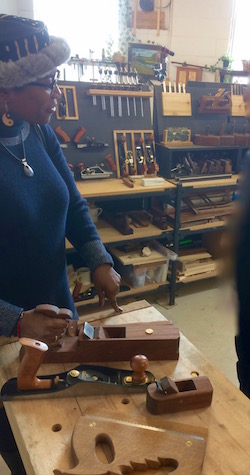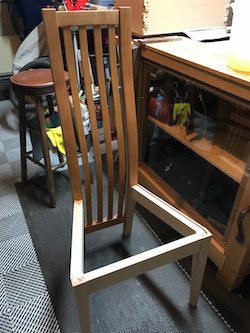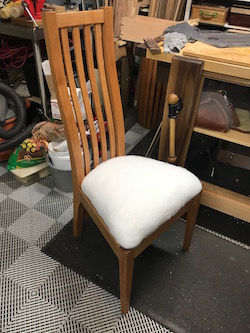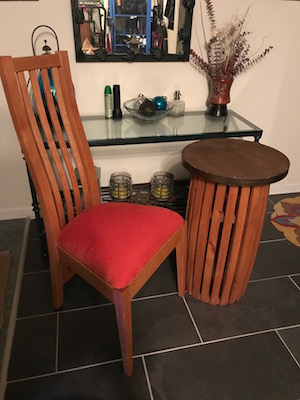I have dreams of woodworking glory. And I have what I call a wish list: place to document this in my mind. Taking classes at a college or woodworking school considered tops in the woodworking arts would be an awesome fulfillment of a dream. It would be a sabbatical, of sorts, not just a workshop here and there.
I would stay and take in the entire experience of the school, the town, and the people.
I could see myself building knowledge, furniture, a friendship or two and the experience of going away and just concentrating on the work.
To study in this woodworking place and here and here
A handful of woodworking schools and programs on my list are:
▪️ The College of the Redwoods in California’s Fine Woodworking Program in Eureka. The program was founded by James Krenov.
▪️ Port Townsend School of Woodworking in Port Townsend, Washington.
▪️ North Bennet Street School in Boston, Massachusettes for cabinetmaking.
▪️ Rowden Atelier in Devon, England founded by David Savage.
▪️ Unplugged Woodshop School in Toronto, Canada, Foundations Program, an extensive course of study in hand tool only woodworking.
The major hurdle, of course, is cost. An undertaking like this is not cheap. I mean the full cost including tuition, temporary housing or rent, and upkeep.
A Dream Disturbed
I visited the Unplugged Woodshop School, located in the Leslieville neighborhood in Toronto. Having serious plans to enroll, I needed to attend the school’s first open house and student exhibition. On this fact finding tour, I wanted to meet and talk with the founder, Tom Fidgen.
It wouldn’t hurt to see the city I would call home for close to a year, if I enrolled.
Before I even set foot in Canada, I looked for affordable rental housing. It was impossibly unaffordable. That cost alone was more than the entire program’s tuition, wood, and supplies.
The inaugural class showcased their final projects. I had a chance to speak with some of the students about the program. Mainly, I wanted to find out how they afforded living there while attending the school.

Except for two students, they were Torontonians or locals. One student was from the American south. Another was sponsored by his home country in Europe. All of them confirmed that the cost of living was high.
After all of that, I was still serious about enrolling in the program. I bundled myself up and drove 14 hours from my midwestern town to Toronto. In the middle of a winter snowstorm. Didn’t I?
A Place I Could Like
I discovered Tom on the web years ago. I watched him transform from a rustic woodworker to a burnished artisan. His woodworking philosophy, using hand tools exclusively, meshed with mine. He was a major influence in my decision to build a hand tool only woodworking shop.
I would love to do it, but this school and all the other schools, require an enormous financial sacrifice. Especially poignant would be the lasting emotional impact!
Armed with the facts before me, it would not take long to decide.
There was no doubt that I could handle the mental and physical demands of any program. Life outside the school, however, was proving to be problematic.
An Awfully Familiar Truth
So, I’d begun an active search for housing before my trip to Toronto. This exercise was unsettling. I researched the web, the local paper and a housing locator service. Let me restate – the market was tight and impossibly unaffordable.
I even reached out to Tom for leads – a referral from a friend – anything. There was nothing that panned out.
There was no way that I could immerse myself in the program and look for a place. Even if I could pull that off, I still needed to have a place to lay my jacket and my tools, in the first place.
In my search, I became aware of the distressing experience of housing insecurity felt by many black Torontonians.
It was a problem that was occurring far too often. Spaces advertised as available had inexplicably become unavailable for black rental applicants. Current occupants were turned out of their apartments suddenly, without cause or proper notice.
The stories reported in the media were disturbing.
This is not something that I cared to confront so far from home. I didn’t feel good. I didn’t feel safe.
Recall what I said earlier:
“I would stay and take in the entire experience of the school, the town, and the people.”
One man at the open house became aware of my hapless search. He offered me space in his basement.
Returning to my earlier thoughts:
“I could see myself building knowledge, furniture, a friendship or two and the experience of going away and just concentrating on the work.”
Just concentrating on the work. That would be impossible. This housing dilemma was another element that I had to consider.
This is a familiar fire. One which required acceptance that the experience may be isolating, stressful, and disheartening. It may even be personally dangerous.
❤️ Say her name.
In real time, my intuition guides me. It helps dampen the noise created by anticipation and fear.
Once more, I thought about it.
Think. Think. Think.
I do think too much.
The school, by itself, is not the only consideration.
Of course, I looked at the pros and cons. It would be a lovely experience. But the housing … a place to stay … that awful price … and “no” to the basement!
I drove home from Toronto still unsure if I could or should even live there as an artisan-woodworker apprentice.
My decision? I voted with my feet, both physically and fiscally, against staying in Toronto.
A Train Ride Away to a Woodworking Place
I’ll continue to go to woodworking classes and workshops offered closer to home. Greyhound or Amtrak will get me there and back.
Whether it’s a week long saw sharpening workshop or a two hour lecture on woodworking theory, I’ve found it. Real treasures do exist … here and there.
One of those lucky treasures for me is J Miller Handcrafted Furniture. I have taken a handful of workshops led by Jeff Miller at his studio including making this wondrous slat back chair.
We used steam bending and lamination techniques that are hallmarks of Jeff’s own work. Shop machines were used to expedite the work. However, hand tooling is used to refine the projects. I would say Jeff runs a hybrid wood shop.

I welcome, always, the opportunity to work on the imposing, ancient band saw. Also there is the vintage table saw and other equipment that Jeff generously allows anyone in class to operate.

By the way, the band saw cuts wood like a hot knife through butter. Old tools and machines like that have a soft touch and mellow feeling to them. Each time that I enter that shop, it’s like I’m greeting an old friend. If that is anthropomorphizing a tool, well, there you have it.

I learn quite a bit in Jeff’s classes. His approach to the work is meditative and experimental. A generous teacher, he shares his knowledge freely.
In addition to the physical workshops, I attend lectures on woodworking thought and design by Jeff and other guest lecturers.
The hand tool events hosted at the shop are excellent in-person opportunities to see, use, and buy tools and books from their manufacturers. In addition to woodworking advice, demonstrations and discussions from today’s best modern tool makers can be had.
Many of the actual makers attend as well as popular figures in the field. You never know who will show up.
Open house or design showcases, featuring not only Jeff’s thought-provoking work but other woodworkers, help answer the question, “does this soothe my creative soul?”
Of course, it does. There is so much to learn. Wherever I go to enhance and grow my skills, it expands my knowledge and confidence. Whomever the teacher, I’m always grateful and consider myself fortunate.

In my own way, I am crafting a lifetime woodworking school curriculum in my head and in my work space. Isn’t that the definition of a self-taught …woodworker, student of the world … anything?
I still have a “wish list: place”; it continues to grow. Like most people, my desires and yearnings are shadowed by real life experiences and practicalities. I trust myself and honor all of the decisions I’ve made.
Place is important.
Back at my workbench? I continue to dream. Behind me is good work. And, oh yes, there is so much more to come.
♥️ -Shirley J

2 thoughts on “● Wish List: Place”
You painted a perfect picture, reading this makes me think that you should be writing a book about your journey in woodwork. PS keep up the good work I love it.
A book – who knows? Another thing for my wish list! I’m glad you are enjoying this journey.